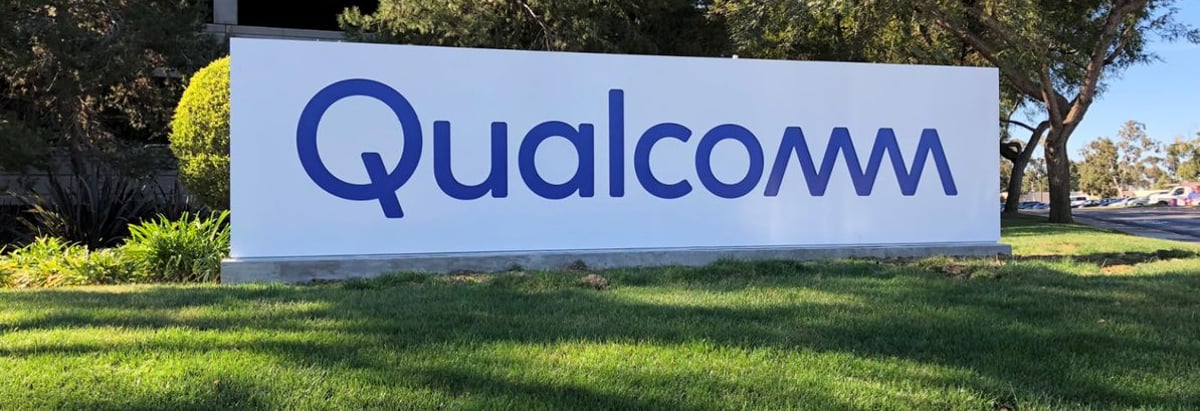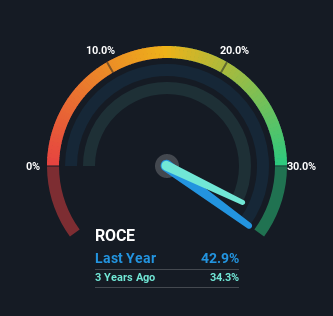- United States
- /
- Semiconductors
- /
- NasdaqGS:QCOM
Returns On Capital Are A Standout For QUALCOMM (NASDAQ:QCOM)

There are a few key trends to look for if we want to identify the next multi-bagger. Amongst other things, we'll want to see two things; firstly, a growing return on capital employed (ROCE) and secondly, an expansion in the company's amount of capital employed. Ultimately, this demonstrates that it's a business that is reinvesting profits at increasing rates of return. Speaking of which, we noticed some great changes in QUALCOMM's (NASDAQ:QCOM) returns on capital, so let's have a look.
Understanding Return On Capital Employed (ROCE)
For those that aren't sure what ROCE is, it measures the amount of pre-tax profits a company can generate from the capital employed in its business. Analysts use this formula to calculate it for QUALCOMM:
Return on Capital Employed = Earnings Before Interest and Tax (EBIT) ÷ (Total Assets - Current Liabilities)
0.43 = US$15b ÷ (US$47b - US$12b) (Based on the trailing twelve months to June 2022).
Therefore, QUALCOMM has an ROCE of 43%. In absolute terms that's a great return and it's even better than the Semiconductor industry average of 15%.
View our latest analysis for QUALCOMM

In the above chart we have measured QUALCOMM's prior ROCE against its prior performance, but the future is arguably more important. If you'd like to see what analysts are forecasting going forward, you should check out our free report for QUALCOMM.
How Are Returns Trending?
You'd find it hard not to be impressed with the ROCE trend at QUALCOMM. The data shows that returns on capital have increased by 312% over the trailing five years. That's a very favorable trend because this means that the company is earning more per dollar of capital that's being employed. In regards to capital employed, QUALCOMM appears to been achieving more with less, since the business is using 36% less capital to run its operation. A business that's shrinking its asset base like this isn't usually typical of a soon to be multi-bagger company.
On a side note, we noticed that the improvement in ROCE appears to be partly fueled by an increase in current liabilities. Effectively this means that suppliers or short-term creditors are now funding 25% of the business, which is more than it was five years ago. It's worth keeping an eye on this because as the percentage of current liabilities to total assets increases, some aspects of risk also increase.
The Bottom Line
In the end, QUALCOMM has proven it's capital allocation skills are good with those higher returns from less amount of capital. And a remarkable 192% total return over the last five years tells us that investors are expecting more good things to come in the future. With that being said, we still think the promising fundamentals mean the company deserves some further due diligence.
QUALCOMM does have some risks, we noticed 2 warning signs (and 1 which is a bit concerning) we think you should know about.
If you'd like to see other companies earning high returns, check out our free list of companies earning high returns with solid balance sheets here.
Valuation is complex, but we're here to simplify it.
Discover if QUALCOMM might be undervalued or overvalued with our detailed analysis, featuring fair value estimates, potential risks, dividends, insider trades, and its financial condition.
Access Free AnalysisHave feedback on this article? Concerned about the content? Get in touch with us directly. Alternatively, email editorial-team (at) simplywallst.com.
This article by Simply Wall St is general in nature. We provide commentary based on historical data and analyst forecasts only using an unbiased methodology and our articles are not intended to be financial advice. It does not constitute a recommendation to buy or sell any stock, and does not take account of your objectives, or your financial situation. We aim to bring you long-term focused analysis driven by fundamental data. Note that our analysis may not factor in the latest price-sensitive company announcements or qualitative material. Simply Wall St has no position in any stocks mentioned.
About NasdaqGS:QCOM
QUALCOMM
Engages in the development and commercialization of foundational technologies for the wireless industry worldwide.
Very undervalued with outstanding track record and pays a dividend.
Similar Companies
Market Insights
Community Narratives



